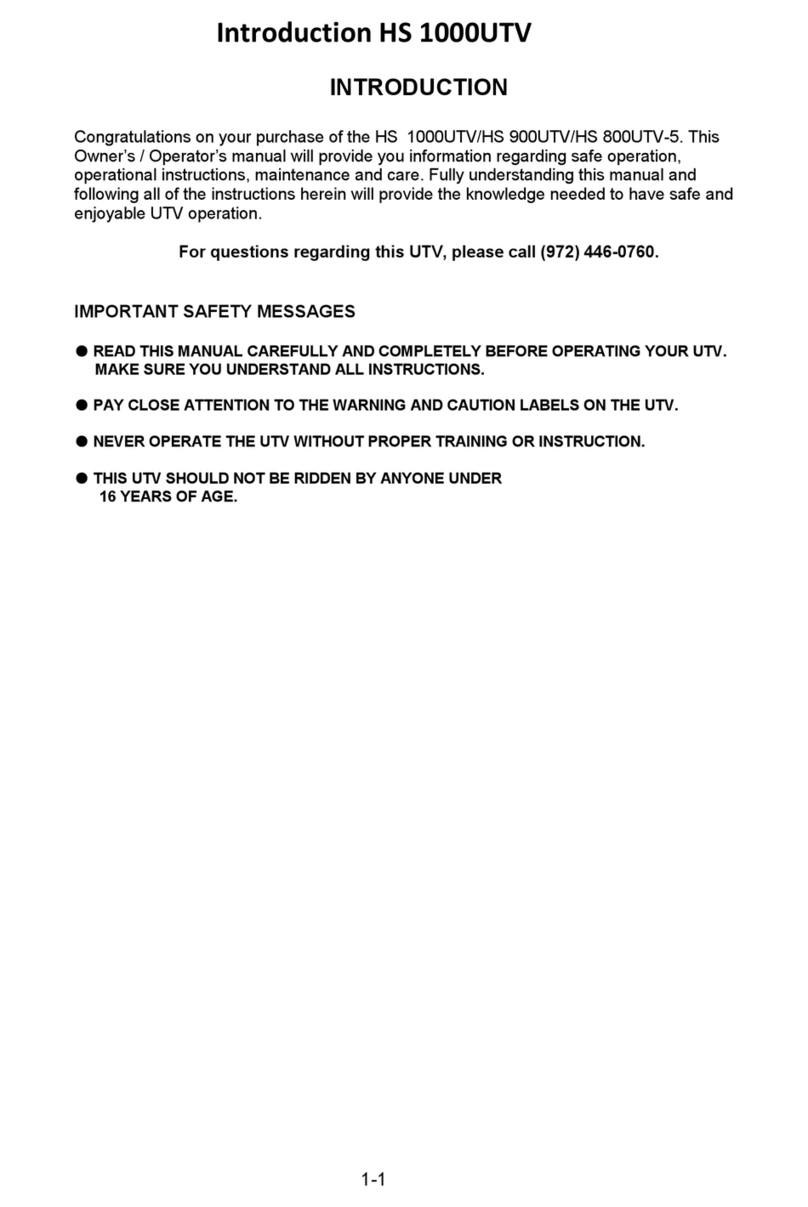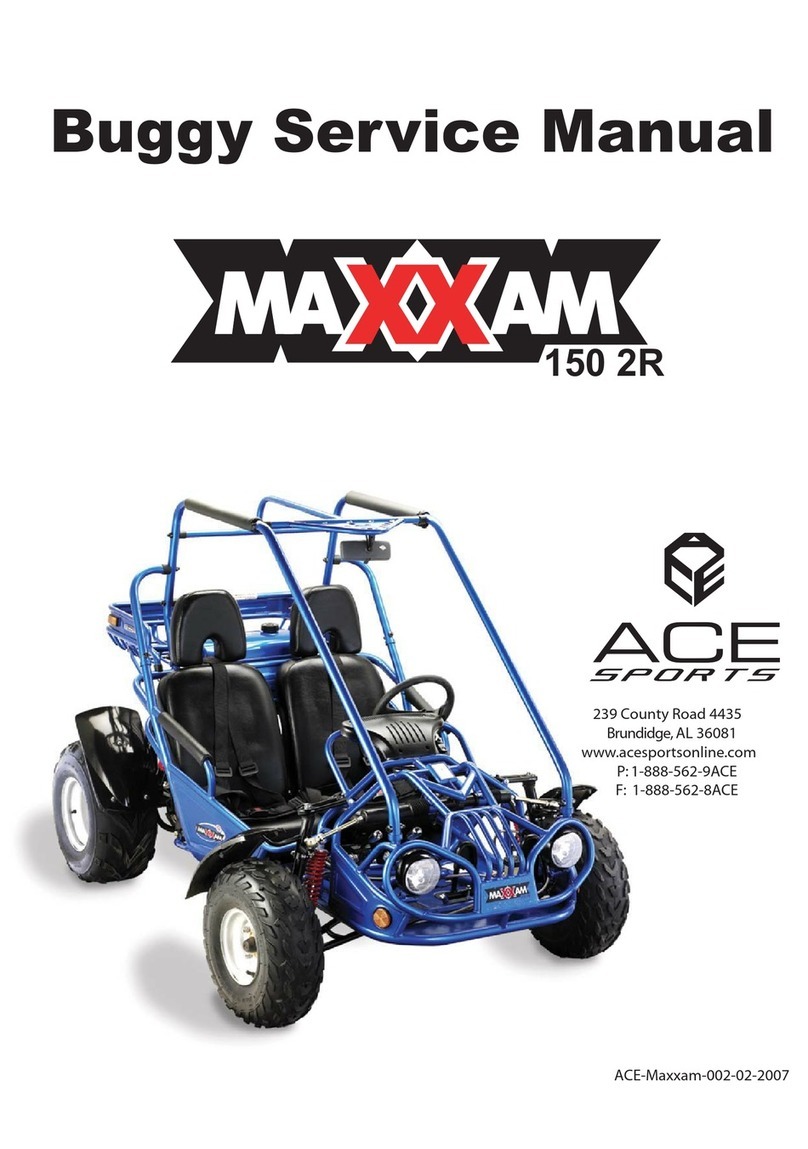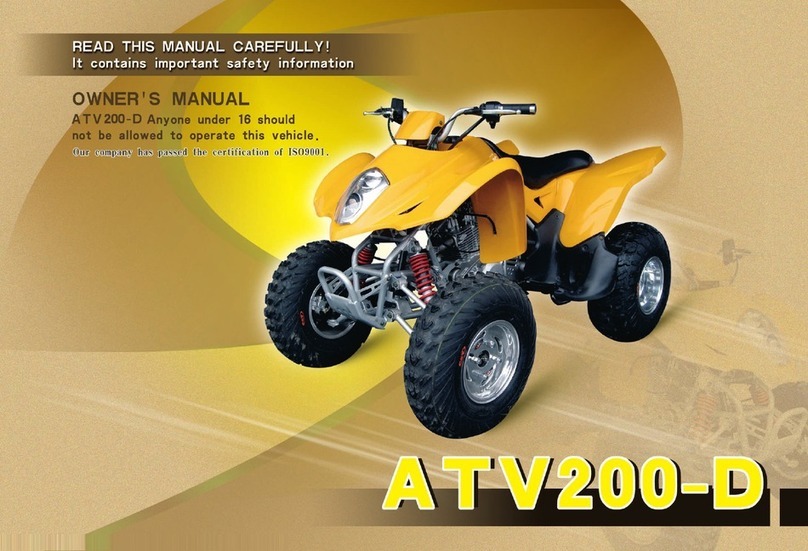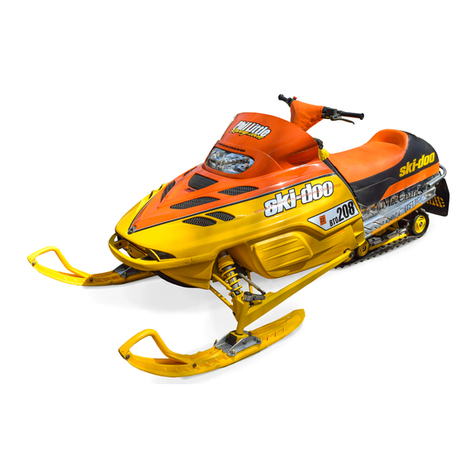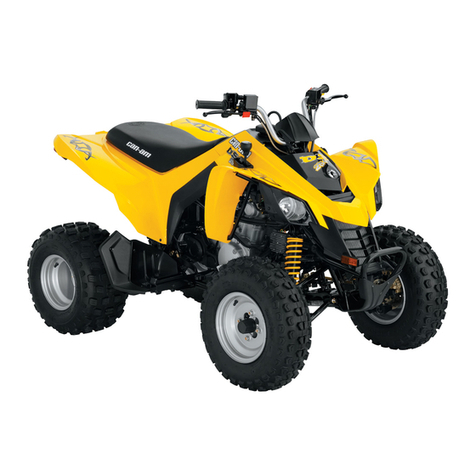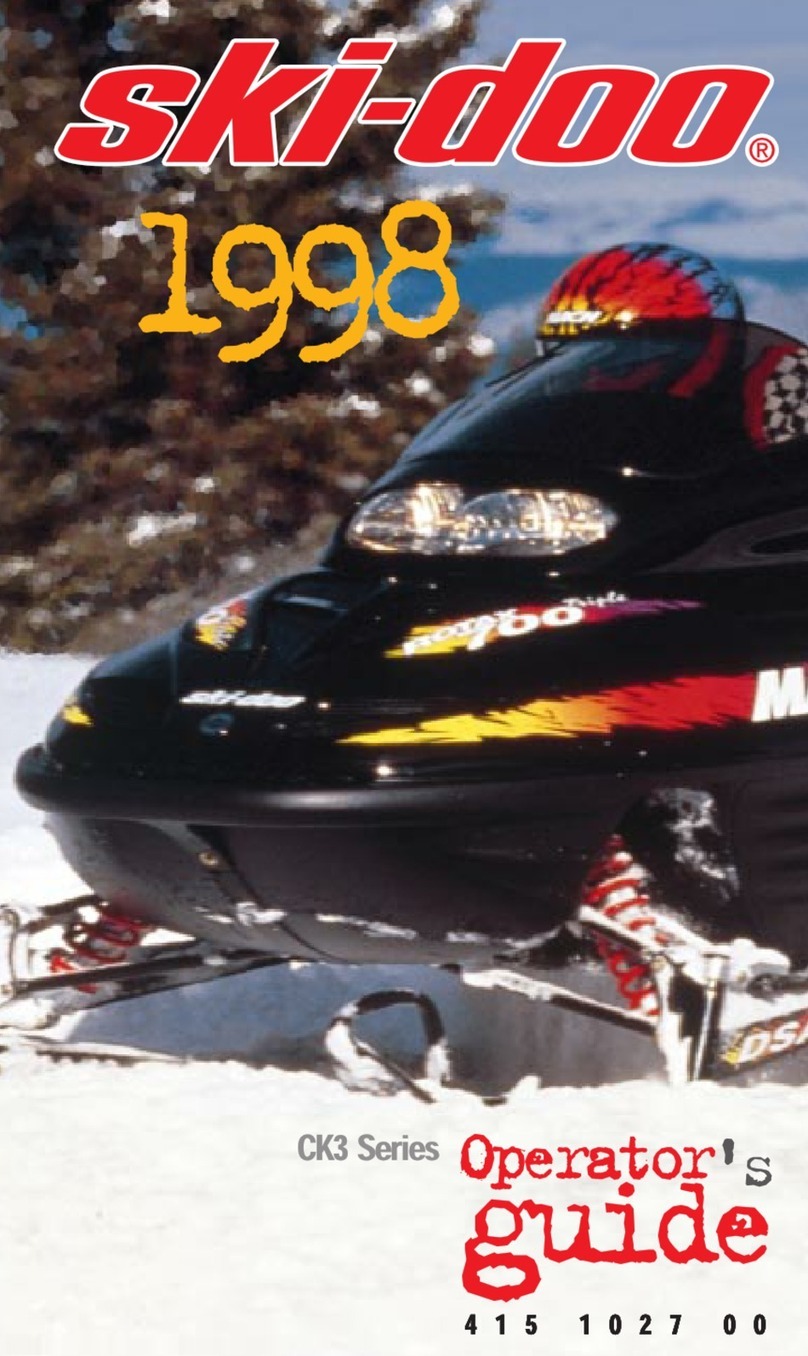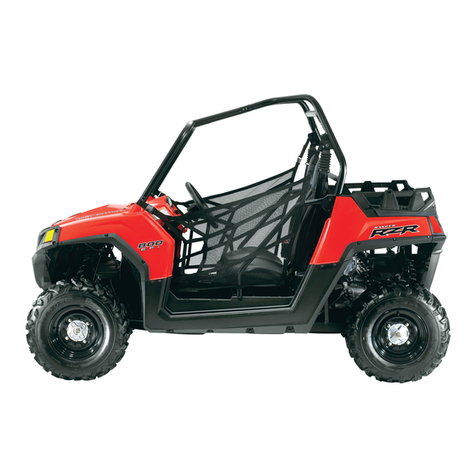Hisun HS800UTV User manual

FOREWORD
Brief introduction to maintenance handbook of HS800UTV
The handbook is edited by Technical Center of Chongqing Huansong Industries
(Group) Co., Ltd., and is supplied to dealers and technicians as document of technique.
Mainly, the handbook gives methods to check, maintain and repair utility terrain
vehicles (UTV), and supplies some relevant technique and performance data. Some
techniques and method inside may be used to check, maintain and repair other models of
UTV, although it is mainly for HS800UTV.
Please read the handbook through and fully understand it; otherwise, any improper
repairing and amounting would bring you problems, and accident may occur in your use.
Proper use and maintenance can guarantee UTV being driven safely, reduce its
malfunction, and help the vehicle remain its best performance.
The standards, performances and specifications mentioned in interpretation are
based on the sample in design, and they are subject to changes according to the
product’s improvement without prior notice.
First version , March,2010
Published by Chongqing Huansong Industries (Group) Co., Ltd.
Chongqing Huansong Industries (Group) Co., Ltd holds the copy right.
No publishing and reprinting without permission.

- 1 -
CONTENT
CHAPTER 1
GENERAL INFORMATION
GENERAL INFORMATION……………………………………………………………………1
WATNINGS, CAUTIONS AND NOTES……………………………………………………1
DESCRIPTION……………………………………………………………………………………2
IDENTIFICATION CODE……………………………………………………………………… 3
Frame No. ………………………………………………………………………………… 3
Engine No. ………………………………………………………………………………… 3
SAFETY ………………………………………………………………………………………… 4
Handing gasoline safely…………………………………………………………………… 4
Cleaning parts……………………………………………………………………………… 5
Warning labels……………………………………………………………………………… 5
SERIAL NUMBERS…………………………………………………………………………… 6
FASTENERS…………………………………………………………………………………… 6
Torque specifications ……………………………………………………………………… 6
Self-locking fasteners……………………………………………………………………… 6
Washers…………………………………………………………………………………… 6
Cotter pins…………………………………………………………………………………… 7
Snap rings and E-clips …………………………………………………………………… 7
SHOP SUPPLIES……………………………………………………………………………… 8
Lubricants and Fluids……………………………………………………………………… 8
Engine oils…………………………………………………………………………………… 8
Greases……………………………………………………………………………………… 8
Brake fluid…………………………………………………………………………………… 9
Coolant……………………………………………………………………………………… 9
Cleaners, Degreasers and solvents …………………………………………………… 9
Gasket sealant…………………………………………………………………………… 9
Gasket remover ………………………………………………………………………… 10
Thread locking compound……………………………………………………………… 10
BASIC TOOLS ………………………………………………………………………………… 10
Screwdrivers……………………………………………………………………………… 11

- 2 -
Wrenches ………………………………………………………………………………… 11
Adjustable wrenches …………………………………………………………………… 12
Socket wrenches, ratchets and handles ……………………………………………… 12
Impact drivers …………………………………………………………………………… 13
Allen wrenches…………………………………………………………………………… 13
Torque wrenches………………………………………………………………………… 14
Torque adapters ………………………………………………………………………… 14
Pliers……………………………………………………………………………………… 15
Snap ring pliers…………………………………………………………………………… 15
Hammers ………………………………………………………………………………… 16
Ignition grounding tool…………………………………………………………………… 16
PRECISION MEASURING TOOLS ………………………………………………………… 16
Feeler gauge ……………………………………………………………………………… 17
Calipers…………………………………………………………………………………… 17
Micrometers……………………………………………………………………………… 18
Adjustment ……………………………………………………………………………… 18
Care ……………………………………………………………………………………… 19
Metric micrometer………………………………………………………………………… 19
Standard inch micrometer……………………………………………………………… 20
Telescoping and small bore gauges…………………………………………………… 21
Dial Indicator……………………………………………………………………………… 21
Compression gauge……………………………………………………………………… 22
Multimeter………………………………………………………………………………… 22
ELECTRICAL SYSTEM FUNDAMENTALS……………………………………………… 22
Voltage …………………………………………………………………………………… 22
Resistance………………………………………………………………………………… 23
Amperage………………………………………………………………………………… 23
BASIC SERVICE METHODS……………………………………………………………… 23
Removing frozen fasteners……………………………………………………………… 24
Removing broken fasteners …………………………………………………………… 25
Repairing damaged threads …………………………………………………………… 25
Stud Removal/Installation ……………………………………………………………… 25
Removing hoses ………………………………………………………………………… 26
Bearings…………………………………………………………………………………… 26

- 3 -
Removal…………………………………………………………………………………… 26
Installation………………………………………………………………………………… 27
Interference fit …………………………………………………………………………… 28
Seal replacement………………………………………………………………………… 29
STORAGE……………………………………………………………………………………… 30
Storage area selection…………………………………………………………………… 30
Preparing the motorcycle for storage …………………………………………………… 30
Returning the UTV to service…………………………………………………… 30
TROVBLESHOOTING……………………………………………………………………… 31
ENGINE PRINCIPLES AND OPERATING REQUIREMENTS………………………… 32
STARTING THE ENGINE ………………………………………………………………… 32
Engine is cold …………………………………………………………………………… 32
Engine is warm…………………………………………………………………………… 32
Starting the engine after a fall or after the engine stalls……………………………… 33
Flooded engine…………………………………………………………………………… 33
Engine cold with air temperature ……………………………………………………… 33
Engine cold with air temperature above 35℃(95°F)……………………………… 33
Cold engine with air temperature below 10℃(50°F) ……………………………… 33
Engine is hot……………………………………………………………………………… 34
Starting the engine after a fall or after the engine stalls……………………………… 34
Flooded engine…………………………………………………………………………… 34
ENGINE WILL NOT START ……………………………………………………………… 35
Identifying the problem ………………………………………………………………… 35
Spark test………………………………………………………………………………… 36
Starter does not turn over or turns over slowly ……………………………………… 37
POOR ENGINE PERFORMANCE………………………………………………………… 37
Engine starts but stalls and is hard to restart…………………………………………… 37
Engine backfires, cuts out or misfires during acceleration…………………………… 37
Engine backfires on deceleration……………………………………………………… 38
Poor fuel mileage………………………………………………………………………… 38
Engine will not idle or idles roughly …………………………………………………… 38
Low engine power ………………………………………………………………………… 38
Poor idle or low speed performance…………………………………………………… 40
Poor high speed performance ………………………………………………………… 40

- 4 -
FUEL SYSTEM……………………………………………………………………………… 41
Rich mixture……………………………………………………………………………… 41
Lean mixture……………………………………………………………………………… 41
ENGINE………………………………………………………………………………………… 42
Engine smoke……………………………………………………………………………… 42
Black smoke ……………………………………………………………………………… 42
Blue smoke………………………………………………………………………………… 42
White smoke or steam…………………………………………………………………… 42
Low engine compression ………………………………………………………………… 42
High engine compression ……………………………………………………………… 43
Engine overheating (cooling system) ………………………………………………… 43
Engine overheating (engine)…………………………………………………………… 43
Preignition………………………………………………………………………………… 43
Detonation………………………………………………………………………………… 44
Power loss ……………………………………………………………………………… 44
engine noises……………………………………………………………………………… 44
ENGLNE LUBRICATION…………………………………………………………………… 45
HIGH OIL CONSUMPTION OR EXCESSIVE……………………………………………… 45
Exhaust smoke…………………………………………………………………………… 45
Low oil pressure ………………………………………………………………………… 45
High oil pressure ………………………………………………………………………… 45
No oil pressure…………………………………………………………………………… 45
Oil level too low…………………………………………………………………………… 46
Oil contamination………………………………………………………………………… 46
CYLINDER LEAK DOWN TEST…………………………………………………………… 46
ELECTRICAL TESTING…………………………………………………………………… 48
Preliminary checks and precautions …………………………………………………… 48
Intermittent problems…………………………………………………………………… 49
Electrical component replacement ……………………………………………………… 50
Test equipment …………………………………………………………………………… 50
Ammeter …………………………………………………………………………………… 50
Self-powered test light …………………………………………………………………… 50
Ohmmeter ………………………………………………………………………………… 51
Jumper wire……………………………………………………………………………… 51

- 5 -
TEST PROCEDURES………………………………………………………………………… 52
Voltage test……………………………………………………………………………… 52
Voltage drop test………………………………………………………………………… 52
Peak voltage test………………………………………………………………………… 53
Continuity test……………………………………………………………………………… 53
Testing for a short with a self-powered test light or ohmmeter……………………… 54
Testing for a short with a test light or voltmeter………………………………………… 54
BRAKE SYSTEM……………………………………………………………………………… 54
Soft or spongy brake lever or pedal…………………………………………………… 54
Brake drag………………………………………………………………………………… 55
Hard brake lever or pedal operation…………………………………………………… 56
Brake Grabs……………………………………………………………………………… 56
Brake squeal or chatter ………………………………………………………………… 56
Leaking brake caliper …………………………………………………………………… 57
Leaking master cylinder………………………………………………………………… 57
CHAPTER 2
SPECIFICATIONS
HOW TO USE CONVERSION TABLE OF UNIT…………………………………………… 58
How to use conversion table…………………………………………………………… 58
Definition of unit ………………………………………………………………………… 58
GEBERAR SPECIFICATIONS ……………………………………………………………… 59
ENGINE SPECIFICATIONS ………………………………………………………………… 62
CHASSIS SPECIFICATIONS………………………………………………………………… 68
ELECTRICAL SPECIFICATIONS…………………………………………………………… 70
TIGHTENING TORQUES …………………………………………………………………… 72
Engine tightening torques………………………………………………………………… 72
Chassis tightening torques ……………………………………………………………… 75
GENERAL TIGHTENING TORQUE SPECIFICATIONS ………………………………… 77
LUBRICATION PIONTS AND LUBRICANT TYPES……………………………………… 78
Engine……………………………………………………………………………………… 78
Chassis……………………………………………………………………………………… 79
HYDROGRAPHIC CHART…………………………………………………………………… 80

- 6 -
ENGINE GEARBOX LUBRICATION OIL PARTH CIRCUIT……………………………… 81
CHAPTER 3
MAINTENCE AND ADJUSTMENT OF THE UTV
MAINTENANCE SCHEDULE……………………………………………………………… 83
ENGINE
Adjusting the valve clearance…………………………………………………………… 85
Checking the spark plug ………………………………………………………………… 88
Checking the ignition timing……………………………………………………………… 89
Measuring the compression pressure………………………………………………… 90
Checking the engine oil level …………………………………………………………… 91
Changing the engine oil ………………………………………………………………… 92
CHASSIS
Cleaning the air filter………………………………………………………………… 94
Checking the coolant level …………………………………………………………… 95
Changing the coolant…………………………………………………………………… 96
Checking the coolant temperature warning light …………………………………… 99
Checking the v-belt……………………………………………………………………… 100
Cleaning the spark arrester …………………………………………………………… 101
Adjusting the brake pedal……………………………………………………………… 102
Checking the brake fluid level ………………………………………………………… 103
Checking the front brake pads………………………………………………………… 104
Checking the rear brake pads………………………………………………………… 104
Checking the brake hoses and brake pipes ………………………………………… 105
Bleeding the hydraulic brake system ………………………………………………… 105
Adjusting the select lever shift rod …………………………………………………… 107
Adjusting the brake light switch ……………………………………………………… 107
Checking the final gear oil level ……………………………………………………… 108
Changing the final gear oil……………………………………………………………… 108
Checking the differential gear oil……………………………………………………… 109
Changing the differential gear oil……………………………………………………… 109
Checking the constant velocity joint dust boots……………………………………… 110

- 7 -
Checking the steering system………………………………………………………… 111
Adjusting the toe-in …………………………………………………………………… 112
Adjusting the front and rearshock absorbers………………………………………… 113
Checking the tires ……………………………………………………………………… 114
Checking the wheels…………………………………………………………………… 116
Checking and lubricating the cables ………………………………………………… 116
ELECTRICAL
Checking and charging the battery…………………………………………………… 117
Checking the fuses …………………………………………………………………… 123
Adjusting the headlight beam ………………………………………………………… 125
Changing the headlight bulb ………………………………………………………… 125
Changing the tail/brake light bulb …………………………………………………… 126
CHAPTER 4
ENGINE
ENGINE NOTE……………………………………………………………………………… 128
ENGINE REMOVAL………………………………………………………………………… 129
CYLINDER HEAD AND CYLINDER HEAD COVER…………………………………… 131
ROCKER ARMS AND CAMSHAFT……………………………………………………… 136
VALVES AND VALVE SPRINGS………………………………………………………… 139
CYLINDER AND PISTON………………………………………………………………… 144
ENGINE LEFT CRANKCASE COVER A.C. MAGNETO…………………………………148
STARTER MOTOR AND OIL FILTER………………………………………………………152
PRIMARY AND SECONDARY SHEAVES…………………………………………………156
CRANKCASE COVER AND OIL PUMP …………………………………………………160
CRANKCASE AND MIDDLE DRIVEN SHAFT ……………………………………………164
OUTPUT SHAFT………………………………………………………………………………170
GEARCASE
Shift lever and oil pump ………………………………………………………………………174
Gearcase transmission ……………………………………………………………………… 176

- 8 -
CHAPTER 5
CHASSIS
MALFUNCTION INSPECTION…………………………………………………………… 181
DIRECTION SYSTEM
The structure of the steering…………………………………………………………… 184
The structure of steering wheel part…………………………………………………… 188
Diassembling the parts of the steering wheel ………………………………………… 188
Checking the parts of the steering wheel……………………………………………… 188
Diassembling the steering column parts……………………………………………… 189
Checking and service the steering column parts……………………………………… 190
Diassembling the steering drive axle ………………………………………………… 190
Checking and service the steering drive axle………………………………………… 191
The machine parts………………………………………………………………… 192
The structure of the steering………………………………………………………… 192
BRAKE SYSTEM…………………………………………………………………………… 193
Preparation for checking before the maintenance of the brake system …………… 193
Disk brake components ……………………………………………………………… 194
Front brake caliper ……………………………………………………………………… 196
Checking the front brake disc ………………………………………………………… 198
Replacing the front brake pads………………………………………………………… 199
Disassembling the front brake calipers ……………………………………………… 201
Assembling the front brake calipers…………………………………………………… 202
Installing the front brake calipers …………………………………………………… 202
Rear brake calipers……………………………………………………………………… 204
Checking the rear brake disc…………………………………………………………… 207
Replacing the rear brake pads………………………………………………………… 208
Disassembling the rear brake caliper ………………………………………………… 209
Assembling the rear brake caliper ………………………………………………… 210
Installing the rear brake caliper ………………………………………………… 212
Checking the master cylinder ………………………………………………………… 213
Assembling the brake master cylinder………………………………………………… 213
Installing the brake master cylinder…………………………………………………… 214

- 9 -
FOOTREST ASSEMBLY ………………………………………………………………… 215
WHEEL AND TYRE PARTS ……………………………………………………………… 218
Front wheels……………………………………………………………………………… 218
Rear wheels……………………………………………………………………………… 219
Checking the wheel tyre………………………………………………………………… 220
Checking the wheel hub………………………………………………………………… 220
Installing the wheel hub………………………………………………………………… 221
Installing the wheel tyre………………………………………………………………… 221
Specification of wheel and tyre………………………………………………………… 222
TRANSMISSION SYSTEM ………………………………………………………………… 223
Front bridge……………………………………………………………………………… 223
Disassembling the universal joint …………………………………………………… 229
Checking the joints……………………………………………………………………… 230
Assembling the universal joint……………………………………………………………231
Rear bridge ……………………………………………………………………………… 232
REVERSE MECHANISM PARTS ……………………………………………………… 239
Adjusting reverse mechanism parts ………………………………………………… 241
Checking and service of reverse mechanism………………………………………… 242
SUSPENSION……………………………………………………………………………… 243
Front Suspension……………………………………………………………………… 243
Front arm…………………………………………………………………………… 245
Disassembling, service and assembly the supporting rocker parts………………… 247
Checking the stabilizer…………………………………………………………………… 248
Checking the steering knuckles………………………………………………………… 248
Checking the front arms ………………………………………………………………… 248
Checking the front shock absorber…………………………………………………… 249
Installing the front arms and front shock absorber ………………………………… 250
Rear suspension ……………………………………………………………………… 251
Rear arm shaft…………………………………………………………………………… 252
Checking and service of rear suspension …………………………………………… 254
Checking the stabilizer…………………………………………………………………… 255
Checking the steering knuckles………………………………………………………… 255
Checking the rear arms………………………………………………………………… 255
Checking the rear shock absorber ………………………………………… 255

- 10 -
Installing the rear arms and rear shock absorber …………………………………… 256
COOLING SYSTEM………………………………………………………………………… 257
Radiator ………………………………………………………………………………… 257
Checking the radiator…………………………………………………………………… 261
Installing the radiator…………………………………………………………………… 262
Oil cooler …………………………………………………………………………… 263
Checking the oil cooler ………………………………………………………………… 265
Water pump……………………………………………………………………………… 266
Disassembling the water pump ……………………………………………………… 270
Checking the water pump……………………………………………………………… 271
Assembling the water pump…………………………………………………………… 272
SEAT ………………………………………………………………………………………… 273
Disassembling the seat……………………………………………………… 277
Moving seat forward and backward …………………………………………………… 277
FUEL TANK………………………………………………………………………………… 278
CHAPTER 6
ELECTRICAL COMPONENTS
ELECTRICAL SYSTEM MALFUNCTION INSPECTION ……………………………… 281
ELECTRICAL ……………………………………………………………………………… 282
ELECTRICALCOMPONENTS……………………………………………………………… 282
CHECKING THE SWITCH……………………………………………………………… 284
Checking the switch…………………………………………………………………… 284
Checking the switch continuity ……………………………………………………… 285
CHECKING THE BULBS AND BULB SOCKETS …………………………………… 286
IGNITION SYSTEM ……………………………………………………………………… 287
CIRCUIT DIAGRAM ……………………………………………………………………… 287
TROUBLESHOOTING …………………………………………………………………… 288
ELECTRIC STARTING SYSTEM ……………………………………………………… 291
CIRCUIT DIAGRAM ……………………………………………………………………… 291
TROUBLESHOOTING …………………………………………………………………… 292
STARTER MOTOR ……………………………………………………………………… 295

- 11 -
Checking the starter motor …………………………………………………………… 296
Assembling the starter motor ………………………………………………………… 297
CHARGING SYSTEM …………………………………………………………………… 298
Circuit diagram………………………………………………………………………… 298
TROUBLESHOOTING …………………………………………………………………… 299
LIGHTING SYSTEM ……………………………………………………………………… 301
CIRCUIT DIAGRAM ……………………………………………………………………… 301
TROUBLESHOOTING …………………………………………………………………… 302
CHECKING THE LIGHTING SYSTEM ………………………………………………… 303
If the headlights fail to come on ……………………………………………………… 303
If the taillights fail to come on ……………………………………………………… 304
SIGNALING SYSTEM …………………………………………………………………… 305
CIRCUIT DIAGRAM ……………………………………………………………………… 305
TROUBLESHOOTING …………………………………………………………………… 306
CHECKING THE SIGNAL SYSTEM …………………………………………………… 307
If the brake lights fail to come on …………………………………………………… 307
If the neutral lights fail to come on ………………………………………………… 308
If the parking brake indicator light fails to come on ………………………………… 309
If the reverse indicator light fails to come on ……………………………………… 310
If the coolant temperature warning ………………………………………………… 311
If the differential gear lock indicator light fails to come on ………………………… 313
If the four-wheel drive indicator light fails to come on …………………………… 315
COOLING SYSTEM ……………………………………………………………………… 317
CIRCUIT DIAGRAM ……………………………………………………………………… 317
TROUBLESHOOTING …………………………………………………………………… 318
2WD/4WD SELECTING SYSTEM ……………………………………………………… 321
CIRCUIT DIAGRAM ……………………………………………………………………… 321
TROUBLESHOOTING …………………………………………………………………… 322
CHAPTER 7
ENGINE MANAGEMENT SYSTEM
INTRODUCTION
Ems (engine management system) …………………………………………………… 323

- 12 -
Typical components of EMS………………………………………………………………323
Layout of EMS components………………………………………………………………324
COMPONENTS OF EMS
Electronic control unit …………………………………………………………………… 324
Multec 3.5 injectors ……………………………………………………………………… 325
Throttle body assembly(with stepper motor) …………………………………………329
Engine coolant temperature sensor …………………………………………………… 331
Intake air pressure and temperature sensor ……………………………………………331
Oxygen sensor …………………………………………………………………………… 332
Ignition coil………………………………………………………………………………… 332
Fuel pump module…………………………………………………………………………336
EMS FAULT DIAGNOSIS
EME fault diagnosis ………………………………………………………………………342
Fault code list………………………………………………………………………………342
CHAPTER 8
TROUBLESHOOTING
STARTING FAILURE/HARD STARTING………………………………………………… 344
Fuel system ……………………………………………………………………………… 344
Electrical system ………………………………………………………………………… 344
Compression system …………………………………………………………………… 345
POOR IDLE SPEED PERFORMANCE ………………………………………………… 345
Poor idle speed performance…………………………………………………………… 345
POOR MEDIUM AND HIGH-SPEED PERFORMANCE ……………………………… 346
Poor medium and high-speed performance………………………………………… 346
FAULTY GEAR SHIFTING………………………………………………………………… 346
Shift lever does not move ……………………………………………………………… 346
Jumps out of gear……………………………………………………………………… 346
OVERHEATING……………………………………………………………………………… 346
Overheating……………………………………………………………………………… 346
FAULTY BRAKE…………………………………………………………………………… 347
Poor braking effect……………………………………………………………………… 347

- 13 -
SHOCK ABSORBER MALFUNCTION………………………………………………… 347
Malfunction ……………………………………………………………………………… 347
UNSTABLE HANDLING…………………………………………………………………… 347
Unstable handling ……………………………………………………………………… 345
LIGHTING SYSTEM………………………………………………………………………… 348
Head light is out of work………………………………………………………………… 348
Bulb burnt out…………………………………………………………………………… 348
HS800UTV WIRING DIAGRAM…………………………………………………………… 349

GENERALINFORMATION
-1-
GENERAL INFORMATION
The text provides complete information on maintenance,tune-up repair and overhaul,Hundreds of
photographs and illustrations created during the complete disassembly of four wheel all-terrain
vehicles (UTV) guide the reader through every job,All procedures are in step-by-step format and
designed for the reader who may be working on the UTV for the first time.
WARNINGS, CAUTIONS AND NOTES
The terms WARNING, CAUTION and NOTE have specific meaning in this manual.
WARNING: emphasizes areas where injury or even death could result from negligence.
Mechanical damage may also occur. WARNINGS are to be taken seriously
CAUTION: emphasizes areas where equipment damage could result. Disregarding a
CAUTION could cause permanent mechanical damage. though injury is unlikely.
NOTE: provides additional information to make a step or procedure easier or clearer.
Disregarding a NOTE could cause inconvenience. but would not cause
equipment damage or injury.

GENERALINFORMATION
-2-
DESCRIPTION
1. Headlights
2. Front shock absorber spring
preload Adjusting ring
3. Rear brake fluid reservoir
4. Parking brake lever
5. Driver seat
6. Battery
7. Fuses
8. Left shoulder protection plate
9. Driver seat belt
10. Air filter case (engine and air
intake duct)
11. Cargo bed
12. Tail/brake lights
13. Spark arrester
14. Rear shock absorber assembly
adjusting ring
15. V-belt case
16. Passenger seat belt
17. right shoulder protection plate
18. Spark plug
19. Oil filter cartridge
20. Fuel tank cap
21. Passenger seat
22. rearview mirror
23. Coolant reservoir
24. Radiator cap
25. Steering wheel
26. Light switch
27. Main switch
28. On-Command four-wheel-drive
and differential lock switches
29. Multi-function meter unit
30. Auxiliary DC jack
31. Brake pedal
32. Accelerator pedal
33. Drive select lever
34. passenger handrail
NOTE:
The vehicle you have purchased may
differ slightly from those in the figures of
this manual.

GENERALINFORMATION
-3-
IDENTIFICATION CODE
Frame No.
Frame No. is carved on the right side of front
main frame
Engine No.
Engine NO. Is carved on the right side of the
engine, Figure.

GENERALINFORMATION
- 4 -
SAFETY
Professional mechanics can work for years and never sustain a serous injury or mishap. Follow
these guidelines and practice common sense to safely service the utility terrain venires
1. Do not operate the utility terrain venires in an enclosed area venires The exhaust gasses contain
carbon monoxide. an odorless, colorless and tasteless poisonous gas. Carbon monoxide levels
build quickly in small enclosed areas and can cause unconsciousness and death in a short time.
Make sure to properly ventilate the work area or operate the UTV side
2. Never use gasoline or any extremely flammable liquid to clean parts. Refer to cleaning parts and
handling Gasoline Safely in this section
3. Never smoke or use a torch in the vicinity of flammable liquids, such as gasoline or cleaning
solvent.
4. If welding or brazing on the UTV the fuel tank to a safe distance at least 50ft.(15m) away.
5. Use the correct type and size of tools to avoid damaging fasteners.
6. Keep tools clean and in good condition. Replace or repair worn or damaged equipment.
7. When loosening a tight fastener, be guided by what would happen if the tool slips.
8. When replacing fasteners, make sure the new fasteners are the same size and strength as the
original ones.
9. Keep the work area clean and organized.
10. Wear eye protection anytime the safety of the eyes is in question. This includes procedures that
involve drilling, grinding, hammering, compressed air and chemicals.
11. Wear the correct clothing for the job. Tie up or cover long hair so it does not get caught in moving
equipment.
12. Do not carry sharp tools in clothing pockets.
13. Always have an approved fire extinguisher available. Make sure it is rated for gasoline (Class B)
and electrical (Class C) fires.
14. Do not use compressed air to clean clothes, the UTV or the work area. Debris may be blown into
the eyes or skin. Never direct compressed air at anyone. Do not allow children to use or play with
any compressed air equipment.
15. When using compressed air to dry rotating parts, hold the part so it does not rotate. Do not allow
the force of the air to spin the part. The air jet is capable of rotating parts at extreme speed. The
part may disintegrate of become damaged, causing serious injury.
16. Do not inhale the dust created by brake pad and clutch wear. These particles may contain
asbestos. In addition, some types of insulating materials and gaskets may contain asbestos.
Inhaling asbestos particles is hazardous to one’s health.
17. Never work on the UTV while someone is working under it.
Handling Gasoline Safely
Gasoline is a volatile flammable liquid and is one of the most dangerous items in the shop.
Because gasoline is used so often, many people forget it is hazardous. Only use gasoline as fuel
for gasoline internal combustion engines. Keep in mind when working on the machine, gasoline is
always present in the fuel tank, fuel line and carburetor. To avoid a disastrous accident when
working around the fuel system, carefully observe the following precautions:
1. Never use gasoline to clean parts. Refer to Cleaning Parts in this section.

GENERALINFORMATION
- 5 -
2. When working of the fuel system, work outside or in a well-ventilated area.
3. Do not add fuel to the fuel tank or service the fuel system while the UTV is near open flames,
sparks or where someone is smoking .Gasoline vapor is heavier than air, it collects in low areas
and is more easily ignited than liquid gasoline.
4. Allow the engine to cool completely before working on any fuel system component.
5. Do not store gasoline in glass containers. If the glass breaks, a serious explosion of fire may
occur.
6. Immediately wipe up spilled gasoline with rags. Store the rags in a metal container with a lid until
they can be properly disposed of, or place them outside in a safe place for the fuel to evaporate.
7. Do not pour water onto a gasoline fire. Water spreads the fire and makes it more difficult to put out.
Use a class B, BC or ABC fire extinguisher to extinguish the fire.
8. Always turn off the engine before refueling. Do not spill fuel onto the engine or exhaust system.
Do not overfill the fuel tank. Leave an air space at the top of the tank to allow room for the fuel to
expand due to temperature fluctuations.
Cleaning Parts
Cleaning parts is one of the more tedious and difficult service jobs performed in the home garage.
Many types of chemical cleaners and solvents are available for shop use. Most are poisonous and
extremely flammable. To prevent chemical exposure, vapor buildup, fire and serious injury, observe
each product warning label and note the following:
1. Read and observe the entire product label before using any chemical. Always know what type of
chemical is being used and whether it is poisonous and/or flammable.
2. Do not use more than one type of cleaning solvent at a time. If mixing chemicals is required,
measure the proper amounts according to the manufacturer.
3. Work in a well-ventilated area.
4. Wear chemical-resistant gloves.
5. Wear safety glasses.
6. Wear a vapor respirator if the instructions call for it.
7. Wash hands and arms thoroughly after cleaning parts.
8. Keep chemical products away from children and pets.
9. Thoroughly clean all oil, grease and cleaner residue from any part that must be heated.
10. Use a nylon brush when cleaning parts. Metal brushes may cause a spark.
11. When using a parts washer, only use the solvent recommended by the manufacturer. Make sure
the parts washer is equipped with a metal lid that will lower in case of fire.
Warning Labels
Most manufacturers attach information and warning labels to the UTV. These labels contain
instructions that are important to personal safety when operating, servicing, transporting and storing
the UTV. Refer to the owner’s manual for the description and location of labels. Order replacement
labels from the manufacturer if they are missing or damaged.

GENERALINFORMATION
- 6 -
SERIAL NUMBERS
Serial and identification numbers are stamped on various locations on the frame, engine and
carburetor body. Record these numbers in the Quick Reference Data section in the front of the manual.
Have these numbers available when ordering parts.
FASTENERS
Proper fastener selection and installation is important to ensure the motorcycle operates as
designed and can be serviced efficiently. The choice of original equipment fasteners is not arrived at
by chance. Make sure replacement fasteners meet all the same requirements as the originals
Many screws. Bolts and studs are combined with nuts to secure particular components. to indicate
the size of a nut. Manufactures specify the internal diameter and the thread pitch
The measurement across two flats on a nut or bolt indicates the wrench size
WARNING
Do not install fasteners with a strength
classification lower than what was originally
installed by the manufacturer doing so may cause
equipment failure and or damage
Torque Specifications
The material used in the manufacturing of the UTV may be subjected to uneven stresses if the
fasteners of the various subassemblies are not installed and tightened correctly. Fasteners that are
improperly installed or work loose can cause extensive damage. it is essential to use an accurate
torque wrench as described in this chapter
Self-Locking Fasteners
Several types of bolts. Screws and nuts incorporate a system that creates interference between
the two fasteners. Interference is achieved in various ways. The most common types are the nylon
insert nut and a dry adhesive coating on the threads of a blot.
Self-locking fasteners offer greater holding strength than standard fasteners, which improves their
resistance to vibration. All self-locking fasteners cannot be reused. The materials used to from the lock
become distorted after the initial installation and removal. Discard and replace self-locking fasteners
after removing them. Do not replace self-locking fasteners with standard fasteners.
Washers
The two basic types of washers are flat washers and lock washers. Flat washers are simple discs
with a hole to fit a screw or bolt. Lock washers are used to prevent a fastener from working loose.
Washers can be used as spacers and seals. Or can help distribute fastener load and prevent the
fastener from damaging the component
As with fasteners. When replacing washers make sure the replacement washers are of the same
Table of contents
Other Hisun Offroad Vehicle manuals

Hisun
Hisun HS 500UTV-5/HS User manual

Hisun
Hisun HS 500 User manual
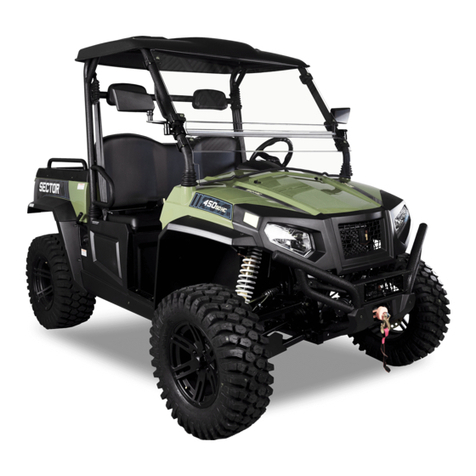
Hisun
Hisun HS 400-4 Reference manual

Hisun
Hisun HS750ATV User manual

Hisun
Hisun HS 200UTV-2 User manual

Hisun
Hisun STRIKE 1000 User manual

Hisun
Hisun HS 400 User manual
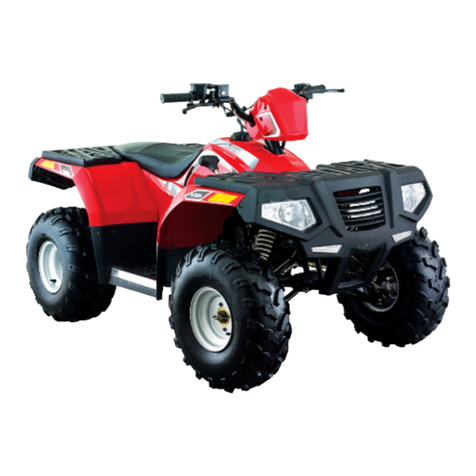
Hisun
Hisun AXIS 110 User manual
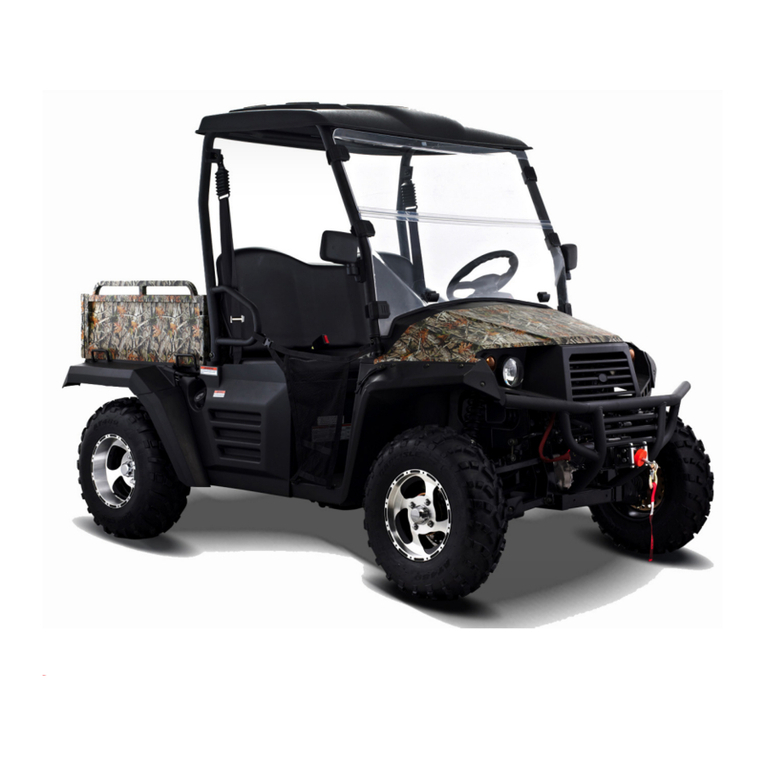
Hisun
Hisun HS 400 User manual

Hisun
Hisun 700UTV User manual
